Detailed HRM Report: Analysis of Boots Company Practices
VerifiedAdded on 2023/01/06
|12
|3411
|27
Report
AI Summary
This report provides a comprehensive analysis of the Human Resource Management (HRM) practices at Boots, a major health and beauty retailer. The report begins with an introduction to Boots and its mission, followed by an overview of HRM functions, including workforce planning and human resource development. It then delves into the recruitment and selection approaches used by Boots, detailing the strengths and weaknesses of both internal and external recruitment methods, as well as various selection techniques like presentations and in-tray tests. The report further examines the benefits of HRM practices, such as flexible organization and performance-based rewards, for both employers and employees. It also assesses the effectiveness of these practices in raising profit and productivity. The importance of employee relations in influencing HRM decision-making is discussed, along with key elements of employment legislation. Finally, the report concludes with an application of certain HRM practices, providing a holistic view of HRM strategies at Boots. This analysis is designed to provide students with a clear understanding of HRM principles and their practical application within a real-world business context.
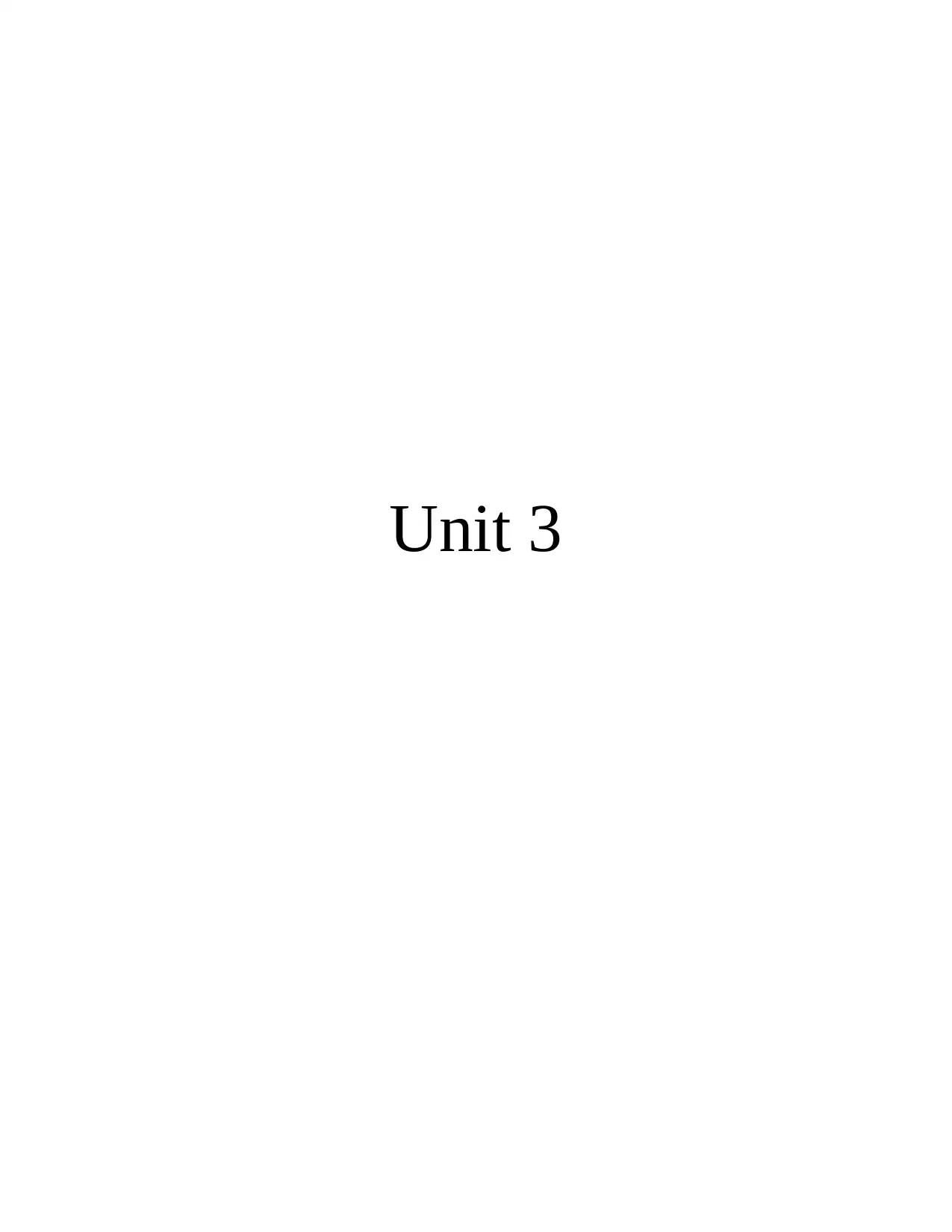
Unit 3
Paraphrase This Document
Need a fresh take? Get an instant paraphrase of this document with our AI Paraphraser
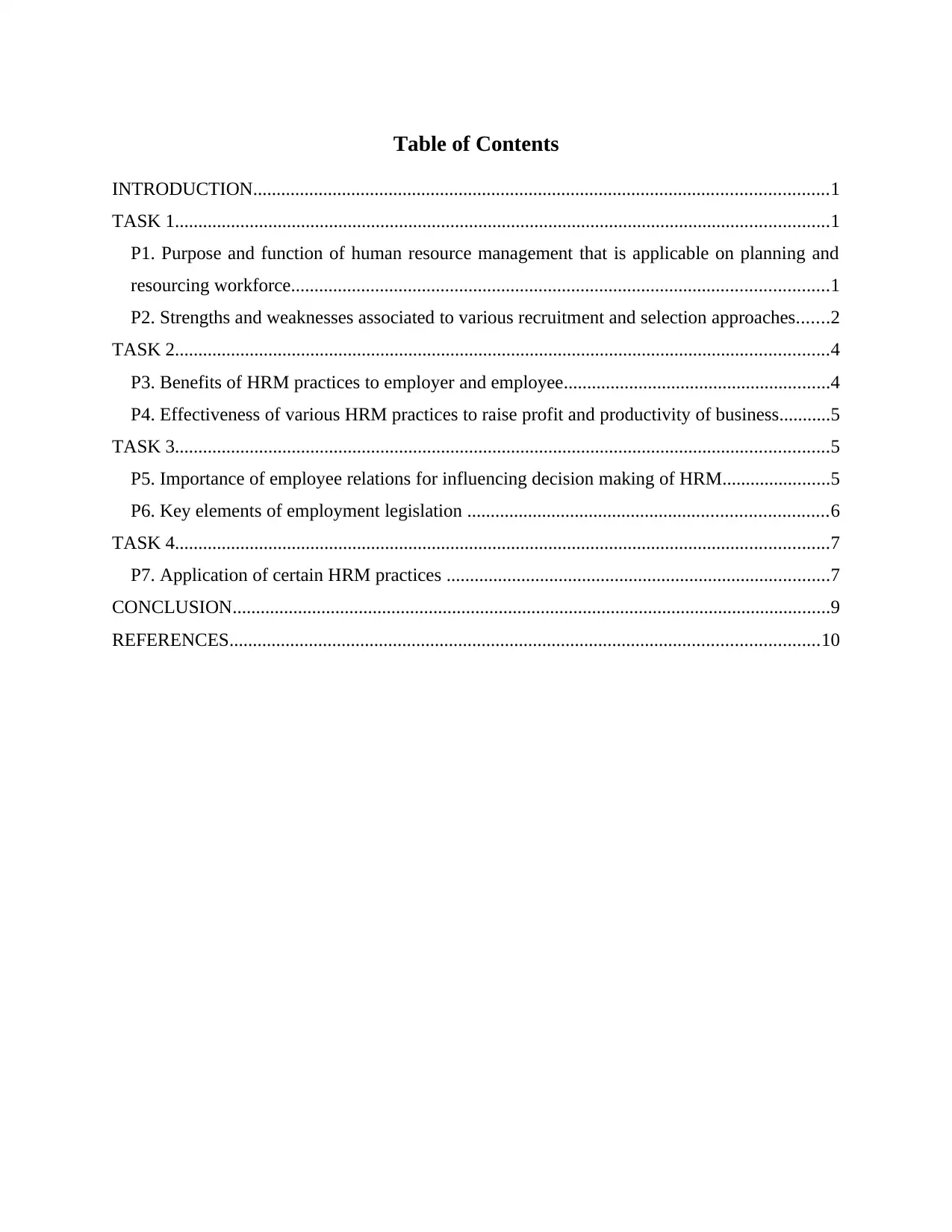
Table of Contents
INTRODUCTION...........................................................................................................................1
TASK 1............................................................................................................................................1
P1. Purpose and function of human resource management that is applicable on planning and
resourcing workforce...................................................................................................................1
P2. Strengths and weaknesses associated to various recruitment and selection approaches.......2
TASK 2............................................................................................................................................4
P3. Benefits of HRM practices to employer and employee.........................................................4
P4. Effectiveness of various HRM practices to raise profit and productivity of business...........5
TASK 3............................................................................................................................................5
P5. Importance of employee relations for influencing decision making of HRM.......................5
P6. Key elements of employment legislation .............................................................................6
TASK 4............................................................................................................................................7
P7. Application of certain HRM practices ..................................................................................7
CONCLUSION................................................................................................................................9
REFERENCES..............................................................................................................................10
INTRODUCTION...........................................................................................................................1
TASK 1............................................................................................................................................1
P1. Purpose and function of human resource management that is applicable on planning and
resourcing workforce...................................................................................................................1
P2. Strengths and weaknesses associated to various recruitment and selection approaches.......2
TASK 2............................................................................................................................................4
P3. Benefits of HRM practices to employer and employee.........................................................4
P4. Effectiveness of various HRM practices to raise profit and productivity of business...........5
TASK 3............................................................................................................................................5
P5. Importance of employee relations for influencing decision making of HRM.......................5
P6. Key elements of employment legislation .............................................................................6
TASK 4............................................................................................................................................7
P7. Application of certain HRM practices ..................................................................................7
CONCLUSION................................................................................................................................9
REFERENCES..............................................................................................................................10
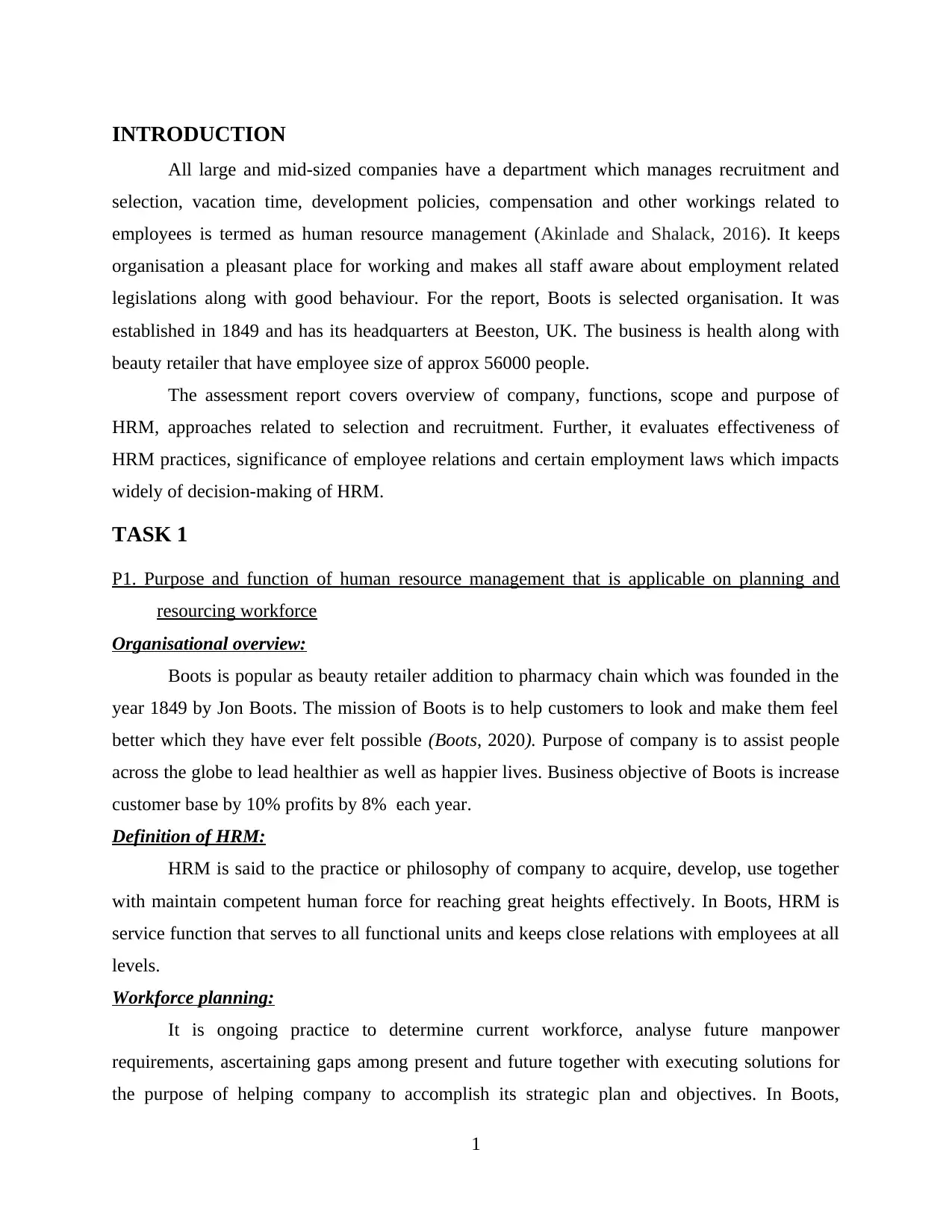
INTRODUCTION
All large and mid-sized companies have a department which manages recruitment and
selection, vacation time, development policies, compensation and other workings related to
employees is termed as human resource management (Akinlade and Shalack, 2016). It keeps
organisation a pleasant place for working and makes all staff aware about employment related
legislations along with good behaviour. For the report, Boots is selected organisation. It was
established in 1849 and has its headquarters at Beeston, UK. The business is health along with
beauty retailer that have employee size of approx 56000 people.
The assessment report covers overview of company, functions, scope and purpose of
HRM, approaches related to selection and recruitment. Further, it evaluates effectiveness of
HRM practices, significance of employee relations and certain employment laws which impacts
widely of decision-making of HRM.
TASK 1
P1. Purpose and function of human resource management that is applicable on planning and
resourcing workforce
Organisational overview:
Boots is popular as beauty retailer addition to pharmacy chain which was founded in the
year 1849 by Jon Boots. The mission of Boots is to help customers to look and make them feel
better which they have ever felt possible (Boots, 2020). Purpose of company is to assist people
across the globe to lead healthier as well as happier lives. Business objective of Boots is increase
customer base by 10% profits by 8% each year.
Definition of HRM:
HRM is said to the practice or philosophy of company to acquire, develop, use together
with maintain competent human force for reaching great heights effectively. In Boots, HRM is
service function that serves to all functional units and keeps close relations with employees at all
levels.
Workforce planning:
It is ongoing practice to determine current workforce, analyse future manpower
requirements, ascertaining gaps among present and future together with executing solutions for
the purpose of helping company to accomplish its strategic plan and objectives. In Boots,
1
All large and mid-sized companies have a department which manages recruitment and
selection, vacation time, development policies, compensation and other workings related to
employees is termed as human resource management (Akinlade and Shalack, 2016). It keeps
organisation a pleasant place for working and makes all staff aware about employment related
legislations along with good behaviour. For the report, Boots is selected organisation. It was
established in 1849 and has its headquarters at Beeston, UK. The business is health along with
beauty retailer that have employee size of approx 56000 people.
The assessment report covers overview of company, functions, scope and purpose of
HRM, approaches related to selection and recruitment. Further, it evaluates effectiveness of
HRM practices, significance of employee relations and certain employment laws which impacts
widely of decision-making of HRM.
TASK 1
P1. Purpose and function of human resource management that is applicable on planning and
resourcing workforce
Organisational overview:
Boots is popular as beauty retailer addition to pharmacy chain which was founded in the
year 1849 by Jon Boots. The mission of Boots is to help customers to look and make them feel
better which they have ever felt possible (Boots, 2020). Purpose of company is to assist people
across the globe to lead healthier as well as happier lives. Business objective of Boots is increase
customer base by 10% profits by 8% each year.
Definition of HRM:
HRM is said to the practice or philosophy of company to acquire, develop, use together
with maintain competent human force for reaching great heights effectively. In Boots, HRM is
service function that serves to all functional units and keeps close relations with employees at all
levels.
Workforce planning:
It is ongoing practice to determine current workforce, analyse future manpower
requirements, ascertaining gaps among present and future together with executing solutions for
the purpose of helping company to accomplish its strategic plan and objectives. In Boots,
1
⊘ This is a preview!⊘
Do you want full access?
Subscribe today to unlock all pages.

Trusted by 1+ million students worldwide
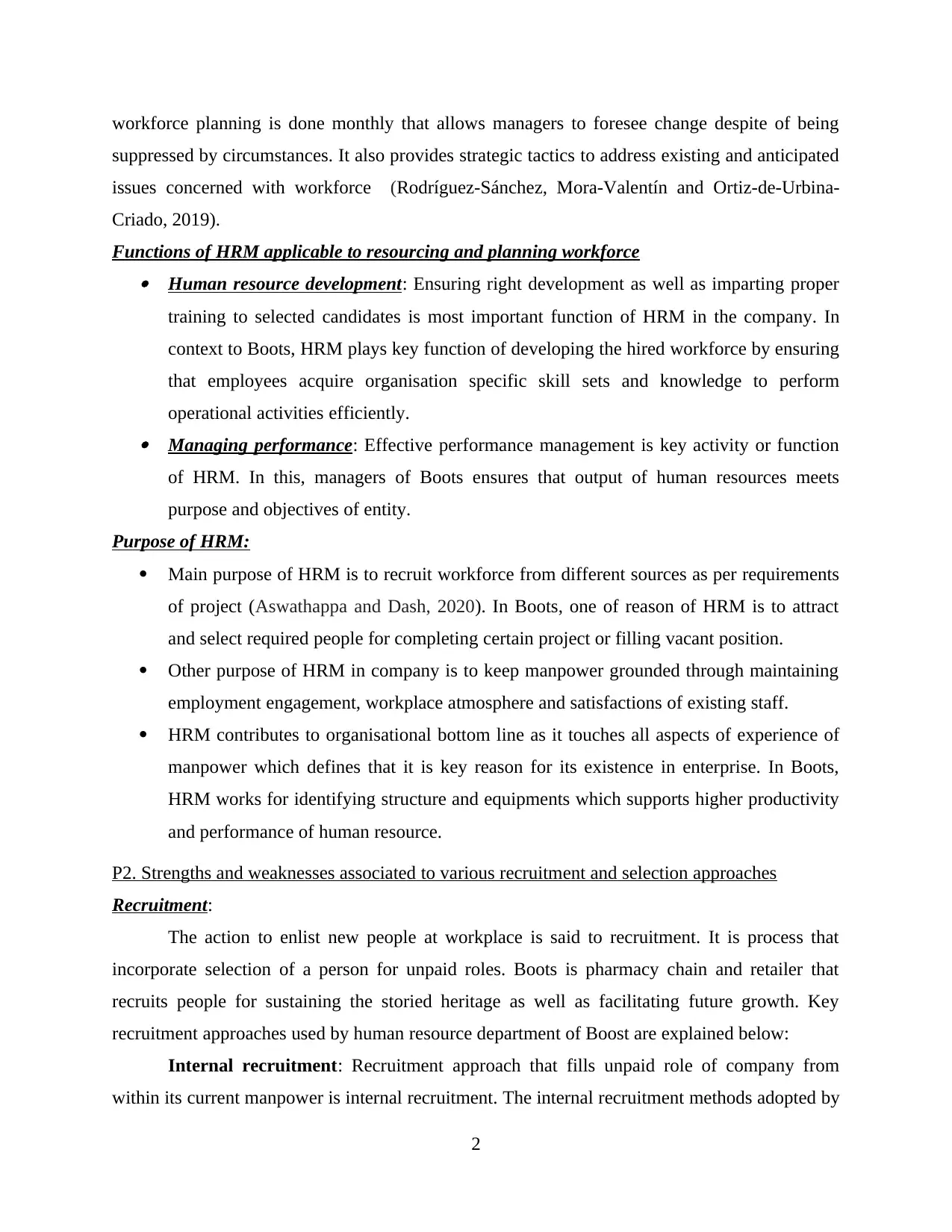
workforce planning is done monthly that allows managers to foresee change despite of being
suppressed by circumstances. It also provides strategic tactics to address existing and anticipated
issues concerned with workforce (Rodríguez-Sánchez, Mora-Valentín and Ortiz-de-Urbina-
Criado, 2019).
Functions of HRM applicable to resourcing and planning workforce Human resource development: Ensuring right development as well as imparting proper
training to selected candidates is most important function of HRM in the company. In
context to Boots, HRM plays key function of developing the hired workforce by ensuring
that employees acquire organisation specific skill sets and knowledge to perform
operational activities efficiently. Managing performance: Effective performance management is key activity or function
of HRM. In this, managers of Boots ensures that output of human resources meets
purpose and objectives of entity.
Purpose of HRM:
Main purpose of HRM is to recruit workforce from different sources as per requirements
of project (Aswathappa and Dash, 2020). In Boots, one of reason of HRM is to attract
and select required people for completing certain project or filling vacant position.
Other purpose of HRM in company is to keep manpower grounded through maintaining
employment engagement, workplace atmosphere and satisfactions of existing staff.
HRM contributes to organisational bottom line as it touches all aspects of experience of
manpower which defines that it is key reason for its existence in enterprise. In Boots,
HRM works for identifying structure and equipments which supports higher productivity
and performance of human resource.
P2. Strengths and weaknesses associated to various recruitment and selection approaches
Recruitment:
The action to enlist new people at workplace is said to recruitment. It is process that
incorporate selection of a person for unpaid roles. Boots is pharmacy chain and retailer that
recruits people for sustaining the storied heritage as well as facilitating future growth. Key
recruitment approaches used by human resource department of Boost are explained below:
Internal recruitment: Recruitment approach that fills unpaid role of company from
within its current manpower is internal recruitment. The internal recruitment methods adopted by
2
suppressed by circumstances. It also provides strategic tactics to address existing and anticipated
issues concerned with workforce (Rodríguez-Sánchez, Mora-Valentín and Ortiz-de-Urbina-
Criado, 2019).
Functions of HRM applicable to resourcing and planning workforce Human resource development: Ensuring right development as well as imparting proper
training to selected candidates is most important function of HRM in the company. In
context to Boots, HRM plays key function of developing the hired workforce by ensuring
that employees acquire organisation specific skill sets and knowledge to perform
operational activities efficiently. Managing performance: Effective performance management is key activity or function
of HRM. In this, managers of Boots ensures that output of human resources meets
purpose and objectives of entity.
Purpose of HRM:
Main purpose of HRM is to recruit workforce from different sources as per requirements
of project (Aswathappa and Dash, 2020). In Boots, one of reason of HRM is to attract
and select required people for completing certain project or filling vacant position.
Other purpose of HRM in company is to keep manpower grounded through maintaining
employment engagement, workplace atmosphere and satisfactions of existing staff.
HRM contributes to organisational bottom line as it touches all aspects of experience of
manpower which defines that it is key reason for its existence in enterprise. In Boots,
HRM works for identifying structure and equipments which supports higher productivity
and performance of human resource.
P2. Strengths and weaknesses associated to various recruitment and selection approaches
Recruitment:
The action to enlist new people at workplace is said to recruitment. It is process that
incorporate selection of a person for unpaid roles. Boots is pharmacy chain and retailer that
recruits people for sustaining the storied heritage as well as facilitating future growth. Key
recruitment approaches used by human resource department of Boost are explained below:
Internal recruitment: Recruitment approach that fills unpaid role of company from
within its current manpower is internal recruitment. The internal recruitment methods adopted by
2
Paraphrase This Document
Need a fresh take? Get an instant paraphrase of this document with our AI Paraphraser
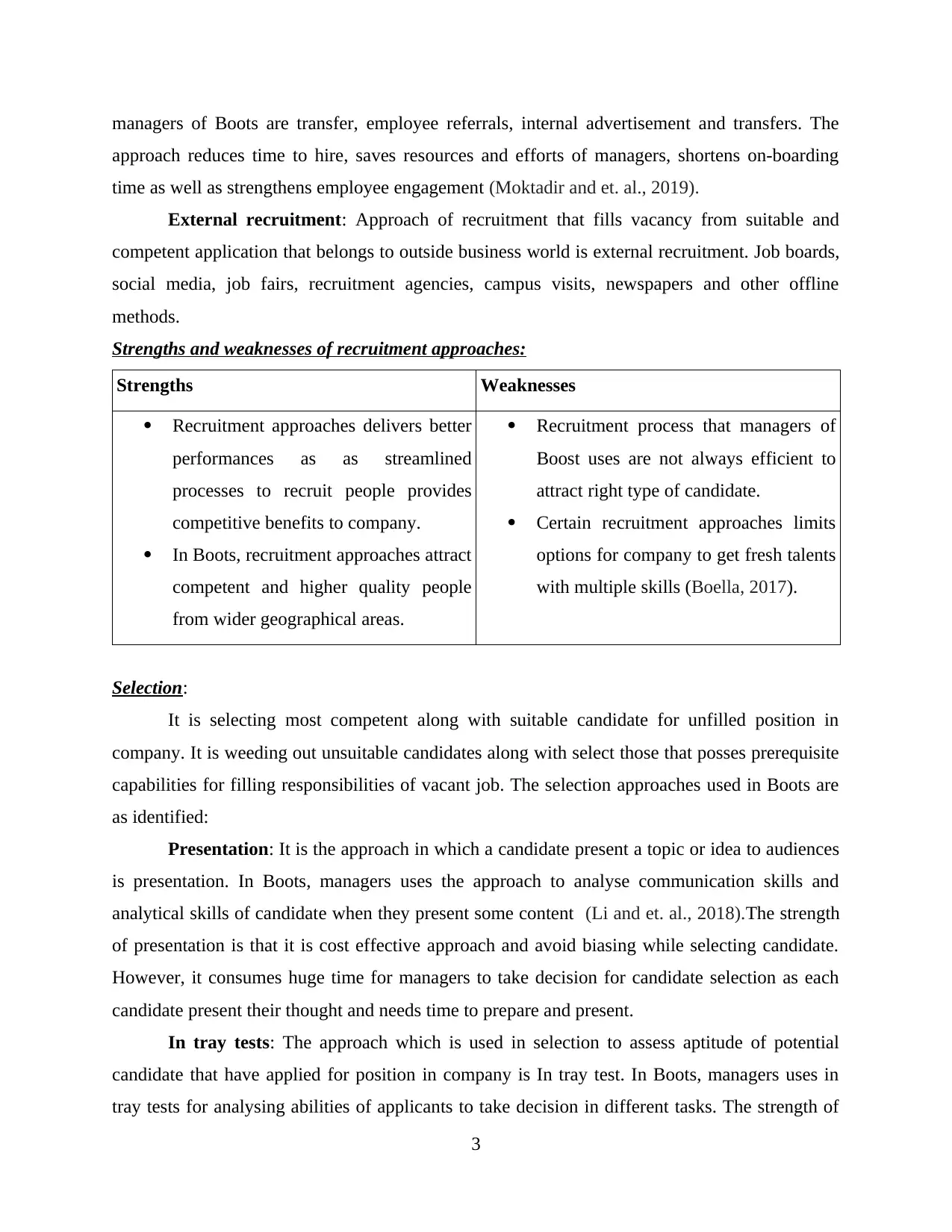
managers of Boots are transfer, employee referrals, internal advertisement and transfers. The
approach reduces time to hire, saves resources and efforts of managers, shortens on-boarding
time as well as strengthens employee engagement (Moktadir and et. al., 2019).
External recruitment: Approach of recruitment that fills vacancy from suitable and
competent application that belongs to outside business world is external recruitment. Job boards,
social media, job fairs, recruitment agencies, campus visits, newspapers and other offline
methods.
Strengths and weaknesses of recruitment approaches:
Strengths Weaknesses
Recruitment approaches delivers better
performances as as streamlined
processes to recruit people provides
competitive benefits to company.
In Boots, recruitment approaches attract
competent and higher quality people
from wider geographical areas.
Recruitment process that managers of
Boost uses are not always efficient to
attract right type of candidate.
Certain recruitment approaches limits
options for company to get fresh talents
with multiple skills (Boella, 2017).
Selection:
It is selecting most competent along with suitable candidate for unfilled position in
company. It is weeding out unsuitable candidates along with select those that posses prerequisite
capabilities for filling responsibilities of vacant job. The selection approaches used in Boots are
as identified:
Presentation: It is the approach in which a candidate present a topic or idea to audiences
is presentation. In Boots, managers uses the approach to analyse communication skills and
analytical skills of candidate when they present some content (Li and et. al., 2018).The strength
of presentation is that it is cost effective approach and avoid biasing while selecting candidate.
However, it consumes huge time for managers to take decision for candidate selection as each
candidate present their thought and needs time to prepare and present.
In tray tests: The approach which is used in selection to assess aptitude of potential
candidate that have applied for position in company is In tray test. In Boots, managers uses in
tray tests for analysing abilities of applicants to take decision in different tasks. The strength of
3
approach reduces time to hire, saves resources and efforts of managers, shortens on-boarding
time as well as strengthens employee engagement (Moktadir and et. al., 2019).
External recruitment: Approach of recruitment that fills vacancy from suitable and
competent application that belongs to outside business world is external recruitment. Job boards,
social media, job fairs, recruitment agencies, campus visits, newspapers and other offline
methods.
Strengths and weaknesses of recruitment approaches:
Strengths Weaknesses
Recruitment approaches delivers better
performances as as streamlined
processes to recruit people provides
competitive benefits to company.
In Boots, recruitment approaches attract
competent and higher quality people
from wider geographical areas.
Recruitment process that managers of
Boost uses are not always efficient to
attract right type of candidate.
Certain recruitment approaches limits
options for company to get fresh talents
with multiple skills (Boella, 2017).
Selection:
It is selecting most competent along with suitable candidate for unfilled position in
company. It is weeding out unsuitable candidates along with select those that posses prerequisite
capabilities for filling responsibilities of vacant job. The selection approaches used in Boots are
as identified:
Presentation: It is the approach in which a candidate present a topic or idea to audiences
is presentation. In Boots, managers uses the approach to analyse communication skills and
analytical skills of candidate when they present some content (Li and et. al., 2018).The strength
of presentation is that it is cost effective approach and avoid biasing while selecting candidate.
However, it consumes huge time for managers to take decision for candidate selection as each
candidate present their thought and needs time to prepare and present.
In tray tests: The approach which is used in selection to assess aptitude of potential
candidate that have applied for position in company is In tray test. In Boots, managers uses in
tray tests for analysing abilities of applicants to take decision in different tasks. The strength of
3
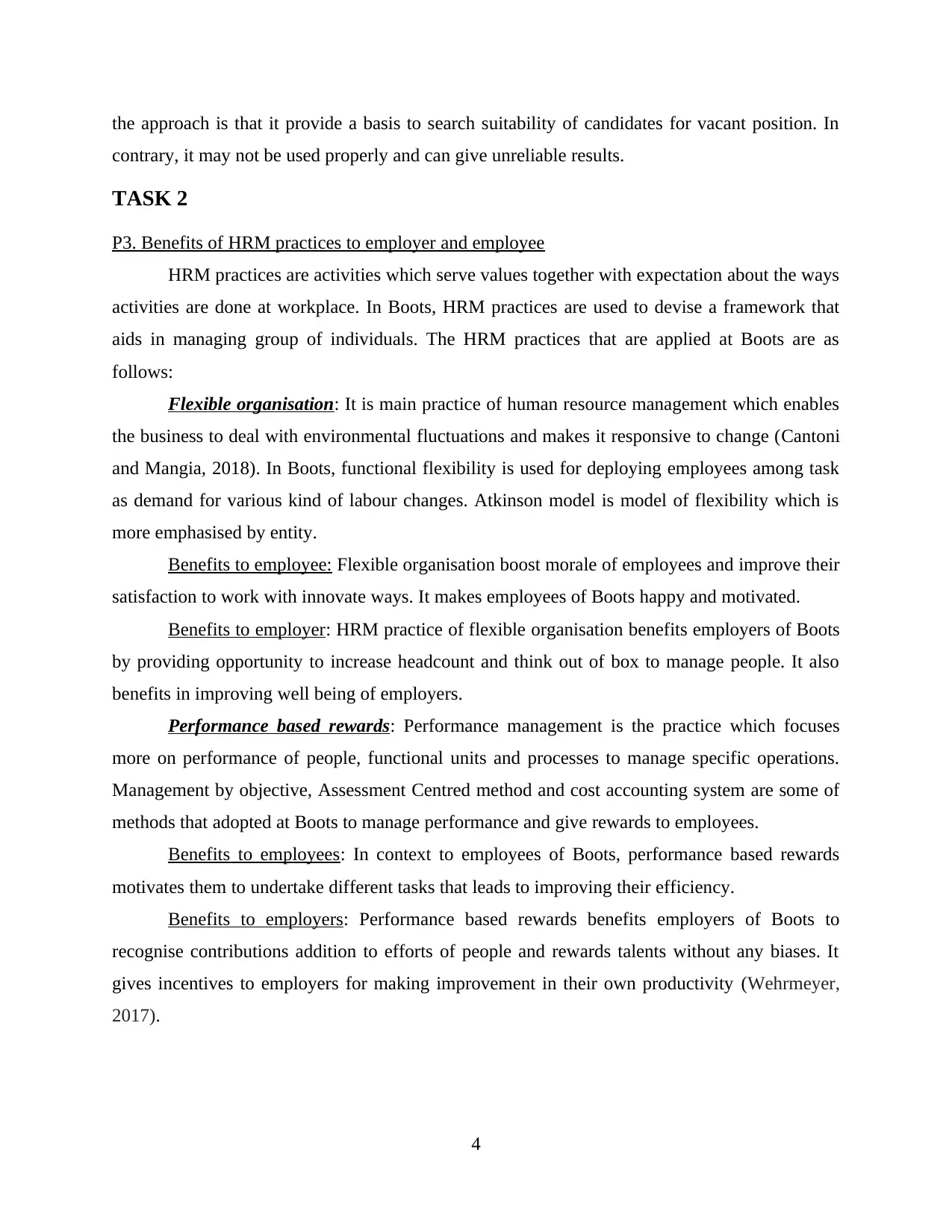
the approach is that it provide a basis to search suitability of candidates for vacant position. In
contrary, it may not be used properly and can give unreliable results.
TASK 2
P3. Benefits of HRM practices to employer and employee
HRM practices are activities which serve values together with expectation about the ways
activities are done at workplace. In Boots, HRM practices are used to devise a framework that
aids in managing group of individuals. The HRM practices that are applied at Boots are as
follows:
Flexible organisation: It is main practice of human resource management which enables
the business to deal with environmental fluctuations and makes it responsive to change (Cantoni
and Mangia, 2018). In Boots, functional flexibility is used for deploying employees among task
as demand for various kind of labour changes. Atkinson model is model of flexibility which is
more emphasised by entity.
Benefits to employee: Flexible organisation boost morale of employees and improve their
satisfaction to work with innovate ways. It makes employees of Boots happy and motivated.
Benefits to employer: HRM practice of flexible organisation benefits employers of Boots
by providing opportunity to increase headcount and think out of box to manage people. It also
benefits in improving well being of employers.
Performance based rewards: Performance management is the practice which focuses
more on performance of people, functional units and processes to manage specific operations.
Management by objective, Assessment Centred method and cost accounting system are some of
methods that adopted at Boots to manage performance and give rewards to employees.
Benefits to employees: In context to employees of Boots, performance based rewards
motivates them to undertake different tasks that leads to improving their efficiency.
Benefits to employers: Performance based rewards benefits employers of Boots to
recognise contributions addition to efforts of people and rewards talents without any biases. It
gives incentives to employers for making improvement in their own productivity (Wehrmeyer,
2017).
4
contrary, it may not be used properly and can give unreliable results.
TASK 2
P3. Benefits of HRM practices to employer and employee
HRM practices are activities which serve values together with expectation about the ways
activities are done at workplace. In Boots, HRM practices are used to devise a framework that
aids in managing group of individuals. The HRM practices that are applied at Boots are as
follows:
Flexible organisation: It is main practice of human resource management which enables
the business to deal with environmental fluctuations and makes it responsive to change (Cantoni
and Mangia, 2018). In Boots, functional flexibility is used for deploying employees among task
as demand for various kind of labour changes. Atkinson model is model of flexibility which is
more emphasised by entity.
Benefits to employee: Flexible organisation boost morale of employees and improve their
satisfaction to work with innovate ways. It makes employees of Boots happy and motivated.
Benefits to employer: HRM practice of flexible organisation benefits employers of Boots
by providing opportunity to increase headcount and think out of box to manage people. It also
benefits in improving well being of employers.
Performance based rewards: Performance management is the practice which focuses
more on performance of people, functional units and processes to manage specific operations.
Management by objective, Assessment Centred method and cost accounting system are some of
methods that adopted at Boots to manage performance and give rewards to employees.
Benefits to employees: In context to employees of Boots, performance based rewards
motivates them to undertake different tasks that leads to improving their efficiency.
Benefits to employers: Performance based rewards benefits employers of Boots to
recognise contributions addition to efforts of people and rewards talents without any biases. It
gives incentives to employers for making improvement in their own productivity (Wehrmeyer,
2017).
4
⊘ This is a preview!⊘
Do you want full access?
Subscribe today to unlock all pages.

Trusted by 1+ million students worldwide
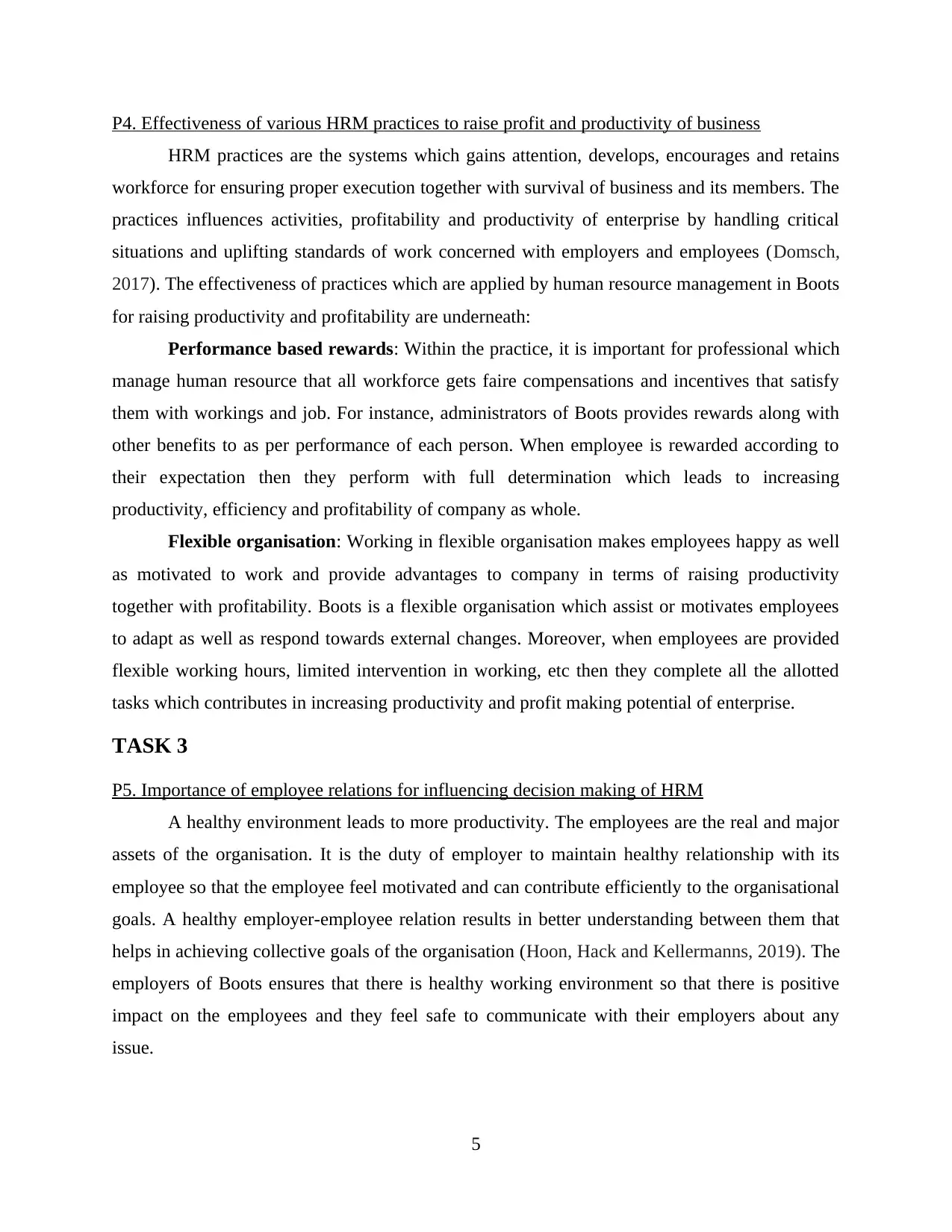
P4. Effectiveness of various HRM practices to raise profit and productivity of business
HRM practices are the systems which gains attention, develops, encourages and retains
workforce for ensuring proper execution together with survival of business and its members. The
practices influences activities, profitability and productivity of enterprise by handling critical
situations and uplifting standards of work concerned with employers and employees (Domsch,
2017). The effectiveness of practices which are applied by human resource management in Boots
for raising productivity and profitability are underneath:
Performance based rewards: Within the practice, it is important for professional which
manage human resource that all workforce gets faire compensations and incentives that satisfy
them with workings and job. For instance, administrators of Boots provides rewards along with
other benefits to as per performance of each person. When employee is rewarded according to
their expectation then they perform with full determination which leads to increasing
productivity, efficiency and profitability of company as whole.
Flexible organisation: Working in flexible organisation makes employees happy as well
as motivated to work and provide advantages to company in terms of raising productivity
together with profitability. Boots is a flexible organisation which assist or motivates employees
to adapt as well as respond towards external changes. Moreover, when employees are provided
flexible working hours, limited intervention in working, etc then they complete all the allotted
tasks which contributes in increasing productivity and profit making potential of enterprise.
TASK 3
P5. Importance of employee relations for influencing decision making of HRM
A healthy environment leads to more productivity. The employees are the real and major
assets of the organisation. It is the duty of employer to maintain healthy relationship with its
employee so that the employee feel motivated and can contribute efficiently to the organisational
goals. A healthy employer-employee relation results in better understanding between them that
helps in achieving collective goals of the organisation (Hoon, Hack and Kellermanns, 2019). The
employers of Boots ensures that there is healthy working environment so that there is positive
impact on the employees and they feel safe to communicate with their employers about any
issue.
5
HRM practices are the systems which gains attention, develops, encourages and retains
workforce for ensuring proper execution together with survival of business and its members. The
practices influences activities, profitability and productivity of enterprise by handling critical
situations and uplifting standards of work concerned with employers and employees (Domsch,
2017). The effectiveness of practices which are applied by human resource management in Boots
for raising productivity and profitability are underneath:
Performance based rewards: Within the practice, it is important for professional which
manage human resource that all workforce gets faire compensations and incentives that satisfy
them with workings and job. For instance, administrators of Boots provides rewards along with
other benefits to as per performance of each person. When employee is rewarded according to
their expectation then they perform with full determination which leads to increasing
productivity, efficiency and profitability of company as whole.
Flexible organisation: Working in flexible organisation makes employees happy as well
as motivated to work and provide advantages to company in terms of raising productivity
together with profitability. Boots is a flexible organisation which assist or motivates employees
to adapt as well as respond towards external changes. Moreover, when employees are provided
flexible working hours, limited intervention in working, etc then they complete all the allotted
tasks which contributes in increasing productivity and profit making potential of enterprise.
TASK 3
P5. Importance of employee relations for influencing decision making of HRM
A healthy environment leads to more productivity. The employees are the real and major
assets of the organisation. It is the duty of employer to maintain healthy relationship with its
employee so that the employee feel motivated and can contribute efficiently to the organisational
goals. A healthy employer-employee relation results in better understanding between them that
helps in achieving collective goals of the organisation (Hoon, Hack and Kellermanns, 2019). The
employers of Boots ensures that there is healthy working environment so that there is positive
impact on the employees and they feel safe to communicate with their employers about any
issue.
5
Paraphrase This Document
Need a fresh take? Get an instant paraphrase of this document with our AI Paraphraser
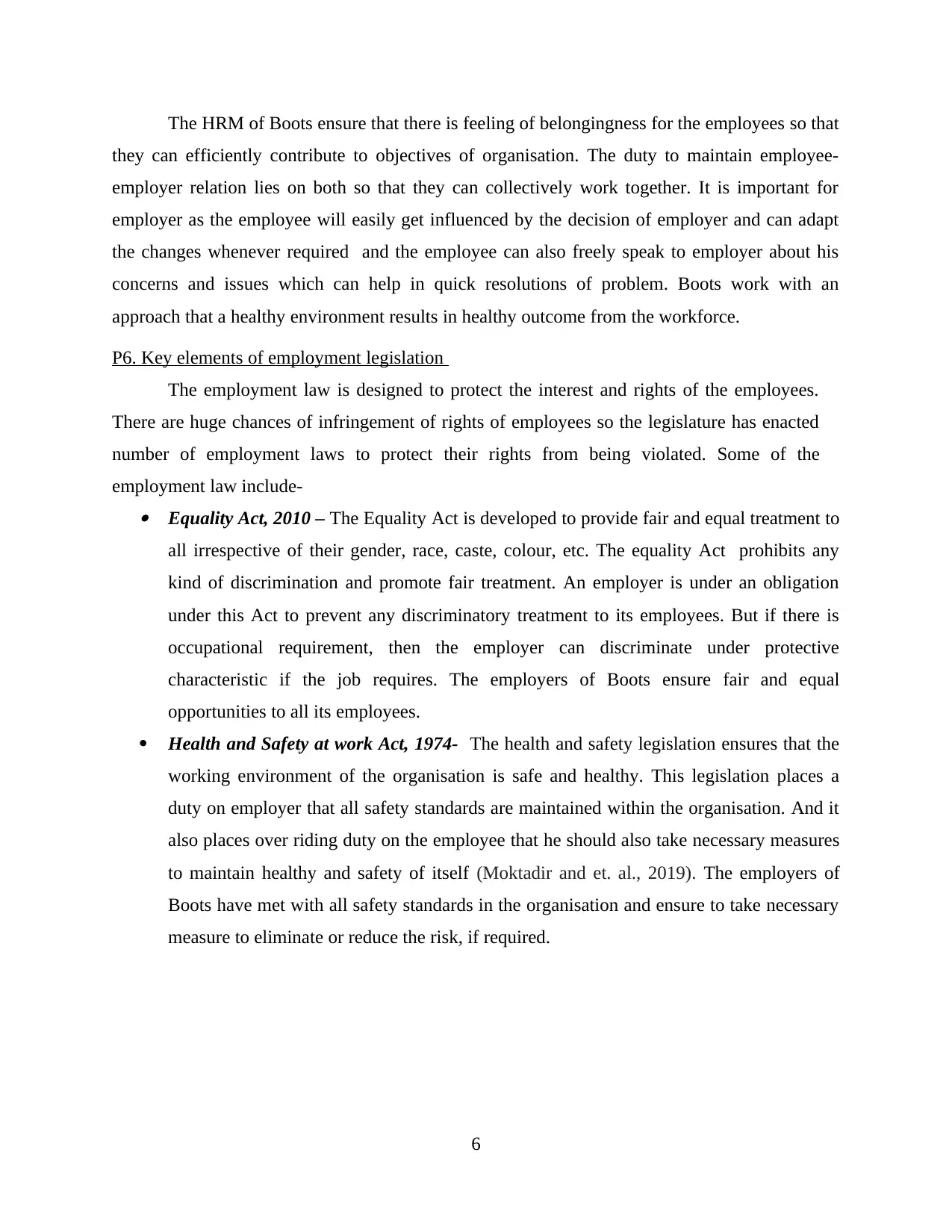
The HRM of Boots ensure that there is feeling of belongingness for the employees so that
they can efficiently contribute to objectives of organisation. The duty to maintain employee-
employer relation lies on both so that they can collectively work together. It is important for
employer as the employee will easily get influenced by the decision of employer and can adapt
the changes whenever required and the employee can also freely speak to employer about his
concerns and issues which can help in quick resolutions of problem. Boots work with an
approach that a healthy environment results in healthy outcome from the workforce.
P6. Key elements of employment legislation
The employment law is designed to protect the interest and rights of the employees.
There are huge chances of infringement of rights of employees so the legislature has enacted
number of employment laws to protect their rights from being violated. Some of the
employment law include- Equality Act, 2010 – The Equality Act is developed to provide fair and equal treatment to
all irrespective of their gender, race, caste, colour, etc. The equality Act prohibits any
kind of discrimination and promote fair treatment. An employer is under an obligation
under this Act to prevent any discriminatory treatment to its employees. But if there is
occupational requirement, then the employer can discriminate under protective
characteristic if the job requires. The employers of Boots ensure fair and equal
opportunities to all its employees.
Health and Safety at work Act, 1974- The health and safety legislation ensures that the
working environment of the organisation is safe and healthy. This legislation places a
duty on employer that all safety standards are maintained within the organisation. And it
also places over riding duty on the employee that he should also take necessary measures
to maintain healthy and safety of itself (Moktadir and et. al., 2019). The employers of
Boots have met with all safety standards in the organisation and ensure to take necessary
measure to eliminate or reduce the risk, if required.
6
they can efficiently contribute to objectives of organisation. The duty to maintain employee-
employer relation lies on both so that they can collectively work together. It is important for
employer as the employee will easily get influenced by the decision of employer and can adapt
the changes whenever required and the employee can also freely speak to employer about his
concerns and issues which can help in quick resolutions of problem. Boots work with an
approach that a healthy environment results in healthy outcome from the workforce.
P6. Key elements of employment legislation
The employment law is designed to protect the interest and rights of the employees.
There are huge chances of infringement of rights of employees so the legislature has enacted
number of employment laws to protect their rights from being violated. Some of the
employment law include- Equality Act, 2010 – The Equality Act is developed to provide fair and equal treatment to
all irrespective of their gender, race, caste, colour, etc. The equality Act prohibits any
kind of discrimination and promote fair treatment. An employer is under an obligation
under this Act to prevent any discriminatory treatment to its employees. But if there is
occupational requirement, then the employer can discriminate under protective
characteristic if the job requires. The employers of Boots ensure fair and equal
opportunities to all its employees.
Health and Safety at work Act, 1974- The health and safety legislation ensures that the
working environment of the organisation is safe and healthy. This legislation places a
duty on employer that all safety standards are maintained within the organisation. And it
also places over riding duty on the employee that he should also take necessary measures
to maintain healthy and safety of itself (Moktadir and et. al., 2019). The employers of
Boots have met with all safety standards in the organisation and ensure to take necessary
measure to eliminate or reduce the risk, if required.
6
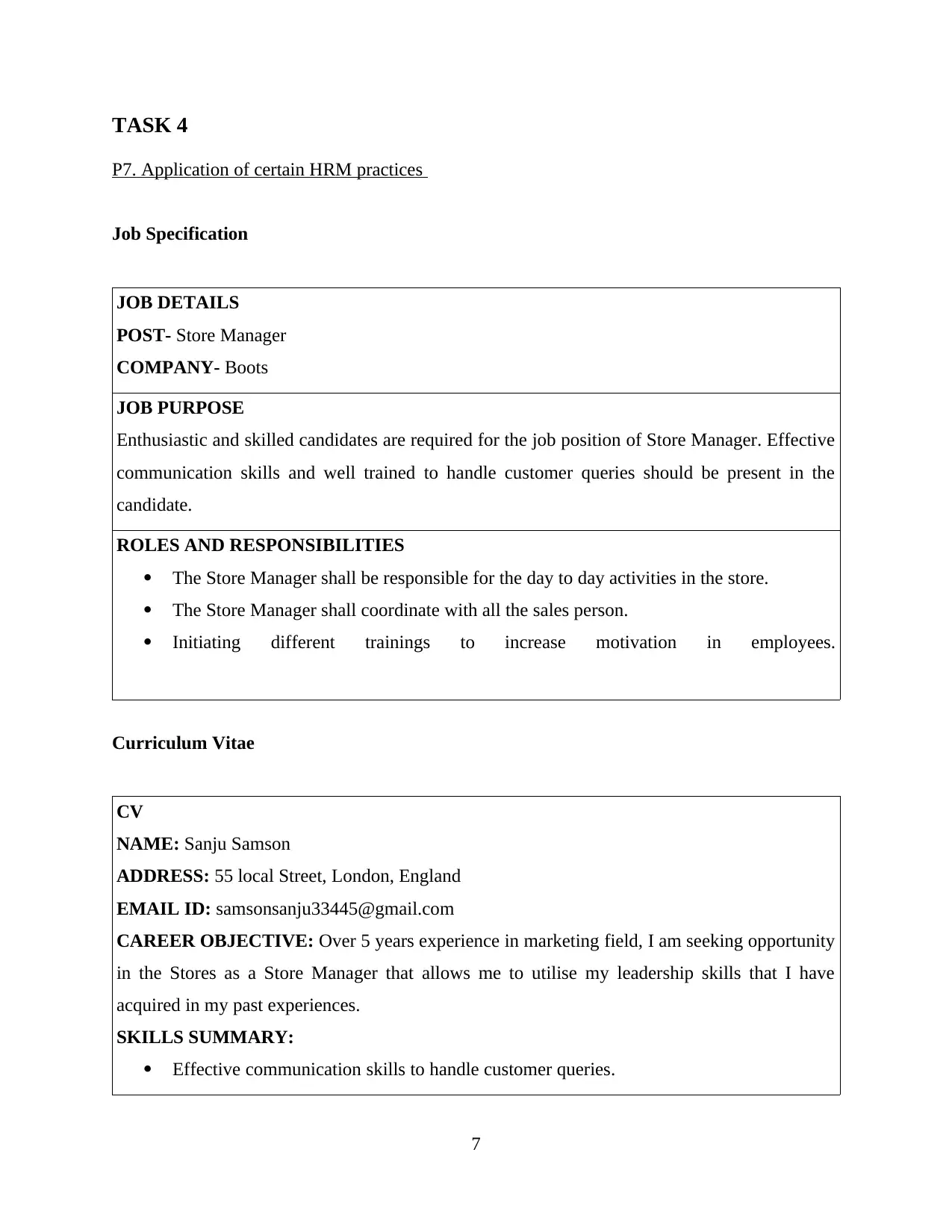
TASK 4
P7. Application of certain HRM practices
Job Specification
JOB DETAILS
POST- Store Manager
COMPANY- Boots
JOB PURPOSE
Enthusiastic and skilled candidates are required for the job position of Store Manager. Effective
communication skills and well trained to handle customer queries should be present in the
candidate.
ROLES AND RESPONSIBILITIES
The Store Manager shall be responsible for the day to day activities in the store.
The Store Manager shall coordinate with all the sales person.
Initiating different trainings to increase motivation in employees.
Curriculum Vitae
CV
NAME: Sanju Samson
ADDRESS: 55 local Street, London, England
EMAIL ID: samsonsanju33445@gmail.com
CAREER OBJECTIVE: Over 5 years experience in marketing field, I am seeking opportunity
in the Stores as a Store Manager that allows me to utilise my leadership skills that I have
acquired in my past experiences.
SKILLS SUMMARY:
Effective communication skills to handle customer queries.
7
P7. Application of certain HRM practices
Job Specification
JOB DETAILS
POST- Store Manager
COMPANY- Boots
JOB PURPOSE
Enthusiastic and skilled candidates are required for the job position of Store Manager. Effective
communication skills and well trained to handle customer queries should be present in the
candidate.
ROLES AND RESPONSIBILITIES
The Store Manager shall be responsible for the day to day activities in the store.
The Store Manager shall coordinate with all the sales person.
Initiating different trainings to increase motivation in employees.
Curriculum Vitae
CV
NAME: Sanju Samson
ADDRESS: 55 local Street, London, England
EMAIL ID: samsonsanju33445@gmail.com
CAREER OBJECTIVE: Over 5 years experience in marketing field, I am seeking opportunity
in the Stores as a Store Manager that allows me to utilise my leadership skills that I have
acquired in my past experiences.
SKILLS SUMMARY:
Effective communication skills to handle customer queries.
7
⊘ This is a preview!⊘
Do you want full access?
Subscribe today to unlock all pages.

Trusted by 1+ million students worldwide
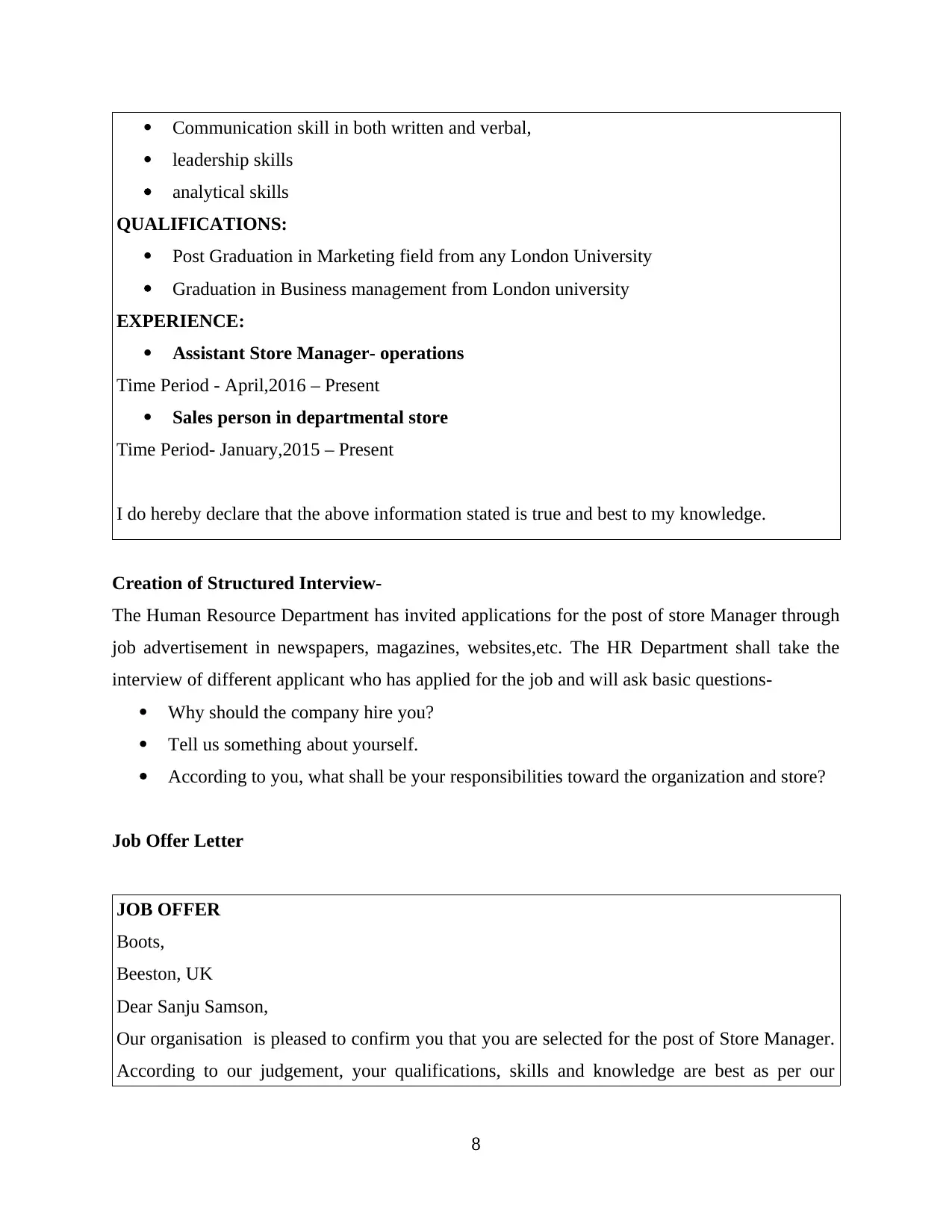
Communication skill in both written and verbal,
leadership skills
analytical skills
QUALIFICATIONS:
Post Graduation in Marketing field from any London University
Graduation in Business management from London university
EXPERIENCE:
Assistant Store Manager- operations
Time Period - April,2016 – Present
Sales person in departmental store
Time Period- January,2015 – Present
I do hereby declare that the above information stated is true and best to my knowledge.
Creation of Structured Interview-
The Human Resource Department has invited applications for the post of store Manager through
job advertisement in newspapers, magazines, websites,etc. The HR Department shall take the
interview of different applicant who has applied for the job and will ask basic questions-
Why should the company hire you?
Tell us something about yourself.
According to you, what shall be your responsibilities toward the organization and store?
Job Offer Letter
JOB OFFER
Boots,
Beeston, UK
Dear Sanju Samson,
Our organisation is pleased to confirm you that you are selected for the post of Store Manager.
According to our judgement, your qualifications, skills and knowledge are best as per our
8
leadership skills
analytical skills
QUALIFICATIONS:
Post Graduation in Marketing field from any London University
Graduation in Business management from London university
EXPERIENCE:
Assistant Store Manager- operations
Time Period - April,2016 – Present
Sales person in departmental store
Time Period- January,2015 – Present
I do hereby declare that the above information stated is true and best to my knowledge.
Creation of Structured Interview-
The Human Resource Department has invited applications for the post of store Manager through
job advertisement in newspapers, magazines, websites,etc. The HR Department shall take the
interview of different applicant who has applied for the job and will ask basic questions-
Why should the company hire you?
Tell us something about yourself.
According to you, what shall be your responsibilities toward the organization and store?
Job Offer Letter
JOB OFFER
Boots,
Beeston, UK
Dear Sanju Samson,
Our organisation is pleased to confirm you that you are selected for the post of Store Manager.
According to our judgement, your qualifications, skills and knowledge are best as per our
8
Paraphrase This Document
Need a fresh take? Get an instant paraphrase of this document with our AI Paraphraser
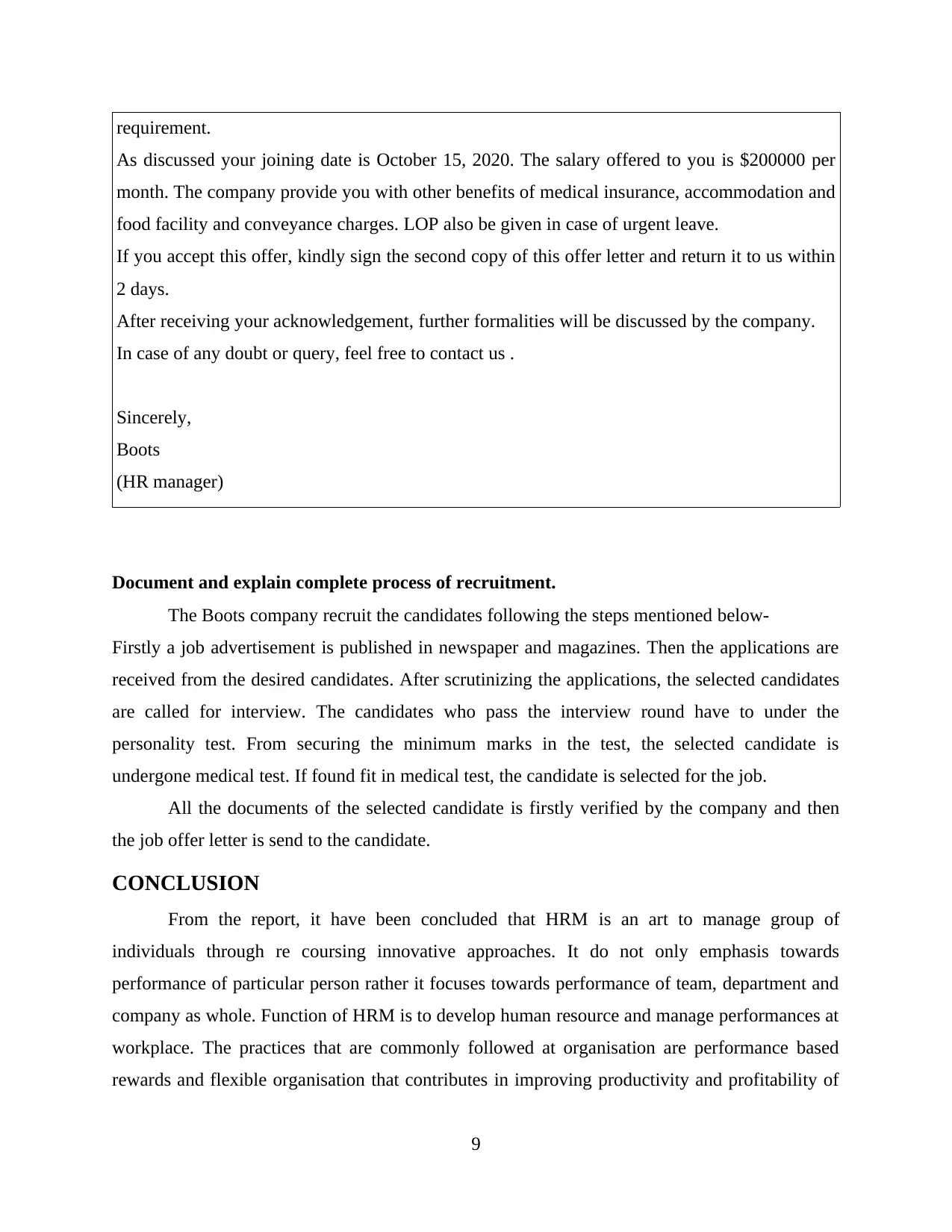
requirement.
As discussed your joining date is October 15, 2020. The salary offered to you is $200000 per
month. The company provide you with other benefits of medical insurance, accommodation and
food facility and conveyance charges. LOP also be given in case of urgent leave.
If you accept this offer, kindly sign the second copy of this offer letter and return it to us within
2 days.
After receiving your acknowledgement, further formalities will be discussed by the company.
In case of any doubt or query, feel free to contact us .
Sincerely,
Boots
(HR manager)
Document and explain complete process of recruitment.
The Boots company recruit the candidates following the steps mentioned below-
Firstly a job advertisement is published in newspaper and magazines. Then the applications are
received from the desired candidates. After scrutinizing the applications, the selected candidates
are called for interview. The candidates who pass the interview round have to under the
personality test. From securing the minimum marks in the test, the selected candidate is
undergone medical test. If found fit in medical test, the candidate is selected for the job.
All the documents of the selected candidate is firstly verified by the company and then
the job offer letter is send to the candidate.
CONCLUSION
From the report, it have been concluded that HRM is an art to manage group of
individuals through re coursing innovative approaches. It do not only emphasis towards
performance of particular person rather it focuses towards performance of team, department and
company as whole. Function of HRM is to develop human resource and manage performances at
workplace. The practices that are commonly followed at organisation are performance based
rewards and flexible organisation that contributes in improving productivity and profitability of
9
As discussed your joining date is October 15, 2020. The salary offered to you is $200000 per
month. The company provide you with other benefits of medical insurance, accommodation and
food facility and conveyance charges. LOP also be given in case of urgent leave.
If you accept this offer, kindly sign the second copy of this offer letter and return it to us within
2 days.
After receiving your acknowledgement, further formalities will be discussed by the company.
In case of any doubt or query, feel free to contact us .
Sincerely,
Boots
(HR manager)
Document and explain complete process of recruitment.
The Boots company recruit the candidates following the steps mentioned below-
Firstly a job advertisement is published in newspaper and magazines. Then the applications are
received from the desired candidates. After scrutinizing the applications, the selected candidates
are called for interview. The candidates who pass the interview round have to under the
personality test. From securing the minimum marks in the test, the selected candidate is
undergone medical test. If found fit in medical test, the candidate is selected for the job.
All the documents of the selected candidate is firstly verified by the company and then
the job offer letter is send to the candidate.
CONCLUSION
From the report, it have been concluded that HRM is an art to manage group of
individuals through re coursing innovative approaches. It do not only emphasis towards
performance of particular person rather it focuses towards performance of team, department and
company as whole. Function of HRM is to develop human resource and manage performances at
workplace. The practices that are commonly followed at organisation are performance based
rewards and flexible organisation that contributes in improving productivity and profitability of
9
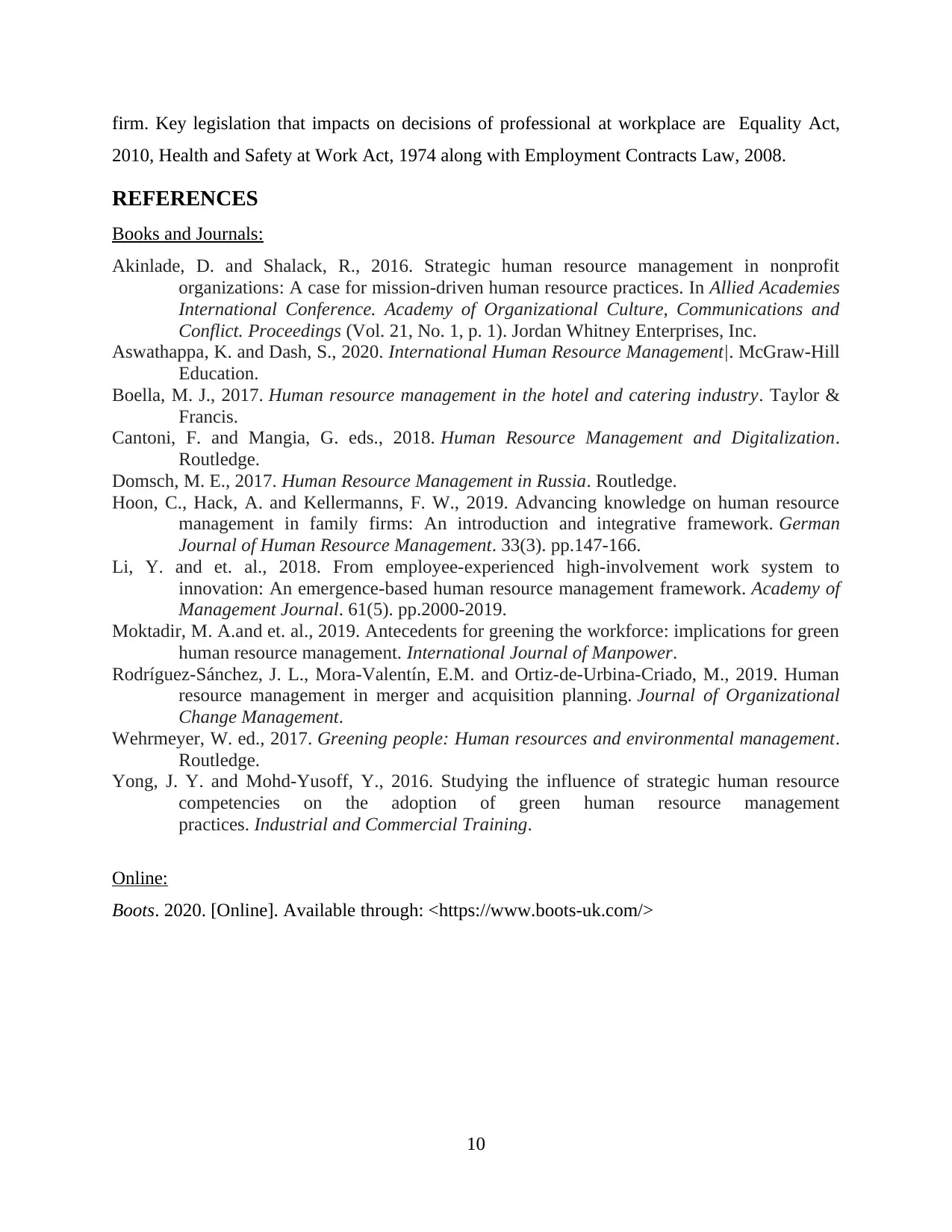
firm. Key legislation that impacts on decisions of professional at workplace are Equality Act,
2010, Health and Safety at Work Act, 1974 along with Employment Contracts Law, 2008.
REFERENCES
Books and Journals:
Akinlade, D. and Shalack, R., 2016. Strategic human resource management in nonprofit
organizations: A case for mission-driven human resource practices. In Allied Academies
International Conference. Academy of Organizational Culture, Communications and
Conflict. Proceedings (Vol. 21, No. 1, p. 1). Jordan Whitney Enterprises, Inc.
Aswathappa, K. and Dash, S., 2020. International Human Resource Management|. McGraw-Hill
Education.
Boella, M. J., 2017. Human resource management in the hotel and catering industry. Taylor &
Francis.
Cantoni, F. and Mangia, G. eds., 2018. Human Resource Management and Digitalization.
Routledge.
Domsch, M. E., 2017. Human Resource Management in Russia. Routledge.
Hoon, C., Hack, A. and Kellermanns, F. W., 2019. Advancing knowledge on human resource
management in family firms: An introduction and integrative framework. German
Journal of Human Resource Management. 33(3). pp.147-166.
Li, Y. and et. al., 2018. From employee-experienced high-involvement work system to
innovation: An emergence-based human resource management framework. Academy of
Management Journal. 61(5). pp.2000-2019.
Moktadir, M. A.and et. al., 2019. Antecedents for greening the workforce: implications for green
human resource management. International Journal of Manpower.
Rodríguez-Sánchez, J. L., Mora-Valentín, E.M. and Ortiz-de-Urbina-Criado, M., 2019. Human
resource management in merger and acquisition planning. Journal of Organizational
Change Management.
Wehrmeyer, W. ed., 2017. Greening people: Human resources and environmental management.
Routledge.
Yong, J. Y. and Mohd-Yusoff, Y., 2016. Studying the influence of strategic human resource
competencies on the adoption of green human resource management
practices. Industrial and Commercial Training.
Online:
Boots. 2020. [Online]. Available through: <https://www.boots-uk.com/>
10
2010, Health and Safety at Work Act, 1974 along with Employment Contracts Law, 2008.
REFERENCES
Books and Journals:
Akinlade, D. and Shalack, R., 2016. Strategic human resource management in nonprofit
organizations: A case for mission-driven human resource practices. In Allied Academies
International Conference. Academy of Organizational Culture, Communications and
Conflict. Proceedings (Vol. 21, No. 1, p. 1). Jordan Whitney Enterprises, Inc.
Aswathappa, K. and Dash, S., 2020. International Human Resource Management|. McGraw-Hill
Education.
Boella, M. J., 2017. Human resource management in the hotel and catering industry. Taylor &
Francis.
Cantoni, F. and Mangia, G. eds., 2018. Human Resource Management and Digitalization.
Routledge.
Domsch, M. E., 2017. Human Resource Management in Russia. Routledge.
Hoon, C., Hack, A. and Kellermanns, F. W., 2019. Advancing knowledge on human resource
management in family firms: An introduction and integrative framework. German
Journal of Human Resource Management. 33(3). pp.147-166.
Li, Y. and et. al., 2018. From employee-experienced high-involvement work system to
innovation: An emergence-based human resource management framework. Academy of
Management Journal. 61(5). pp.2000-2019.
Moktadir, M. A.and et. al., 2019. Antecedents for greening the workforce: implications for green
human resource management. International Journal of Manpower.
Rodríguez-Sánchez, J. L., Mora-Valentín, E.M. and Ortiz-de-Urbina-Criado, M., 2019. Human
resource management in merger and acquisition planning. Journal of Organizational
Change Management.
Wehrmeyer, W. ed., 2017. Greening people: Human resources and environmental management.
Routledge.
Yong, J. Y. and Mohd-Yusoff, Y., 2016. Studying the influence of strategic human resource
competencies on the adoption of green human resource management
practices. Industrial and Commercial Training.
Online:
Boots. 2020. [Online]. Available through: <https://www.boots-uk.com/>
10
⊘ This is a preview!⊘
Do you want full access?
Subscribe today to unlock all pages.

Trusted by 1+ million students worldwide
1 out of 12
Related Documents
Your All-in-One AI-Powered Toolkit for Academic Success.
+13062052269
info@desklib.com
Available 24*7 on WhatsApp / Email
![[object Object]](/_next/static/media/star-bottom.7253800d.svg)
Unlock your academic potential
Copyright © 2020–2025 A2Z Services. All Rights Reserved. Developed and managed by ZUCOL.




